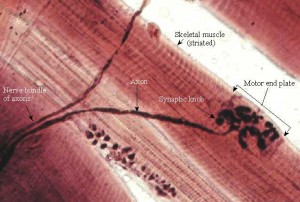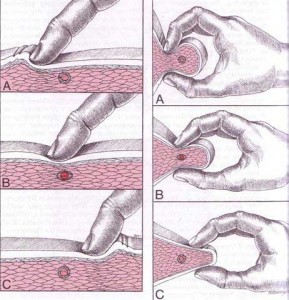Myofascial pain can often be attributed to tiny, yet highly sensitive areas called Trigger Points.
In a nutshell, a trigger point is the painful part of a knot in a muscle. It is a palpable, taut band of skeletal muscle fibers. When pressure is applied to the taut band, one feels an exquisite, localized pain or sensitivity, as well as a radiating referred pain. After about seven to ten seconds of pressure on the point the exquisite pain subsides and the patient may feel a dull, deep pain followed by relief.

What’s happening in the muscle to cause this type of condition?
Our muscles are surrounded by and connected to many types of nerve receptors that allow us to move, feel, and calculate relationship distance. Nociceptors are the receptors that communicate pain. A sensitive locus, or a trigger point, may contain one or more sensitized nociceptive nerve endings. Trigger points are usually distributed with highest concentration near the endplate region of a muscle fiber, where the motor neuron is located.Trigger Points usually develop through overuse or postural dysfunction (think of postural dysfunction as micro areas of overuse). Muscle fibers that aren’t able to fully relax and fully contract are deprived of a consistent nutrient stream. It is sort of analogous to an electronic feedback loop you would experience at a loud concert. The resulting symptoms are chronic pain, limited range of motion and weakness.
How are trigger points treated?
The focus of a manual soft tissue therapist is to address the pain, bottom line. As both a patient and a practitioner, I find trigger point therapy to be effective in relief and a good complement to deep tissue massage, although the sensation of pressure on a TP is subjective–some clients love the diffusing-like sensation, others don’t want to experience the discomfort that accompanies it.
 “Seek & Destroy”
“Seek & Destroy”
I palpate areas where my client complains of pain, and seek out the taut bands. I use my fingers or thumbs to apply pressure either downward on the point (similar to Shiatsu), or a pinscher-like clamp using thumb and forefinger. Often times there is a local twitch response, and the trigger point becomes de-activated. I always massage the soft tissue around a trigger point before and after de-activating to increase circulation. This will flush the waste product from the tissue, and have longer lasting effects for my client.
The developing science around Trigger Points is continual. The go-to resource for most research in this area is a double volume text by Janett Travell & David G. Simons titled Myofascial Pain and Dysfunction. In the book is a comprehensive list of skeletal muscles each with their own common trigger point, origin and insertion, innervation, beautiful illustrations by Barbara D. Cummings, useful techniques to diffuse TP’s, and easy to do stretches intended for rehabilitation.

Travell and Simons’ Myofascial Pain and Dysfunction is a must-have for every body worker. I consult mine all the time. Remember though… while there are numerous charts, diagrams, maps and guidelines for TP’s, our best defense for them is our ability to feel what’s going on in the muscle tissue, and respond intuitively and thoughtfully.

